PISA 2022 assessed 15-year-old students’ capacity to think creatively, defined as the competence to engage in the generation, evaluation and improvement of original and diverse ideas. The PISA 2022 creative thinking data provide insights into how well education systems are preparing students to think outside the box in different task contexts.
PISA 2022 Results (Volume III)

Executive Summary
Student performance in creative thinking
What students can do in creative thinking
Singapore, Korea, Canada*, Australia*, New Zealand*, Estonia and Finland (in descending order) are the highest-performing systems in creative thinking, with a mean score of 36 points or above – significantly above the OECD average (33 points). Students in Singapore score 41 points on average in creative thinking.
There is a large performance gap in creative thinking between the highest-performing and lowest-performing country of 28 score points – or around four proficiency levels. 97 out of 100 students in the five best-performing countries performed above the average student in the five lowest performing countries (Albania**, the Philippines, Uzbekistan, Morocco and the Dominican Republic**).
On average across OECD countries, around 1 in 2 students can think of original and diverse ideas in simple imagination tasks or everyday problem-solving situations (i.e. Proficiency Level 4). In Singapore, Korea and Canada*, over 70% of students performed at or above Level 4.
In Singapore, Latvia*, Korea, Denmark*, Estonia, Canada* and Australia*, more than 88% of students demonstrated a baseline level of creative thinking proficiency (Level 3), meaning they can think of appropriate ideas for a range of tasks and begin to suggest original ideas for familiar problems (OECD average 78%). In 20 low-performing countries/economies, less than 50% of students reached this baseline level.
Creative thinking performance and performance in mathematics and reading
Most countries and economies that scored above the OECD average in creative thinking outperformed the OECD average in mathematics, reading and science. Only Portugal performed above the OECD average in creative thinking (34 points) but not significantly different from the average in the three PISA core domains. Czechia, Hong Kong (China), Macao (China) and Chinese Taipei performed at or below the OECD average in creative thinking despite scoring above the OECD average in mathematics, reading and science.
In Chile, Mexico, Australia*, New Zealand*, Costa Rica, Canada* and El Salvador, students scored over 4.5 points higher than expected in creative thinking after accounting for their mathematics performance. In Singapore, Australia*, Canada*, Latvia*, Korea, Belgium, Finland and New Zealand*, students scored around 3 points or more higher than expected after accounting for their reading performance.
Australia*, Canada*, Finland and New Zealand* combined high mean performance and overall relative performance in creative thinking (i.e. a large relative strength in creative thinking after accounting for students’ reading and mathematics scores, respectively), with at least 75% of students reaching proficiency Level 3.
Academic excellence is not a pre-requisite for excellence in creative thinking. While around half of all students who performed at the highest level in creative thinking performed at the highest level in mathematics, similar proportions of students (over one-quarter, OECD average) within the third quintile of creative thinking performance scored within the second, third and fourth quintiles, respectively, in mathematics. However, very few students below a baseline proficiency in mathematics excelled in creative thinking.
Performance differences across types of tasks
Students in Singapore were the most successful across several task types, especially social problem-solving tasks. Students in Korea were the most successful in scientific problem-solving contexts and evaluate and improve ideas tasks. Students in Portugal performed the most successfully in visual expression tasks.
In general, and after accounting for the difficulty of items across different task groupings, students demonstrated a relative strength in creative expression tasks (both written and visual) compared to their performance across all other tasks, and a relative weakness in creative problem-solving tasks.
Gender and equity gaps in performance
In no country or economy did boys outperform girls in creative thinking, with girls scoring 3 points higher in creative thinking on average across the OECD. The gender gap is significant in all countries/economies after accounting for mathematics performance and in around half of all countries/economies even after accounting for students’ reading performance.
Students with higher socio-economic status performed better in creative thinking, with advantaged students scoring around 9.5 points higher than their disadvantaged peers on average across the OECD. In general, the strength of the association between socio-economic status and performance is weaker in creative thinking than it is for mathematics, reading and science.
Gender and socio-economic differences in performance persist across all types of tasks. Girls performed particularly better than boys in written expression tasks and those requiring them to build on others’ ideas, and socio-economic differences in performance are largest in the written expression domain.
Students’ beliefs and attitudes associated with creative thinking
Around 8 out of 10 students (OECD average) believe that it is possible to be creative in nearly any subject. Students with positive beliefs about the nature of creativity scored around 3 score points higher in creative thinking than other students. However, only around 1 in 2 students (OECD average) believe their creativity is something about them that they can change. Holding a growth mindset on creativity also positively relates to performance (+1 score point, OECD average).
Indices of imagination and adventurousness, openness to intellect, curiosity, perspective taking and persistence are positively associated with creative thinking performance.
School environment
Classroom pedagogies can make a difference. Across OECD countries, between 60-70% of students reported that their teachers value their creativity, that they encourage them to come up with original answers, and that they are given a chance to express their ideas in school. These students scored slightly higher than their peers in creative thinking, even after accounting for students and school characteristics and their mathematics and reading performance.
Participating in school activities such as art, drama, creative writing or programming classes regularly (once a week) is associated with better performance in creative thinking than doing so infrequently or every day.
Table III.1. Snapshot of performance in creative thinking
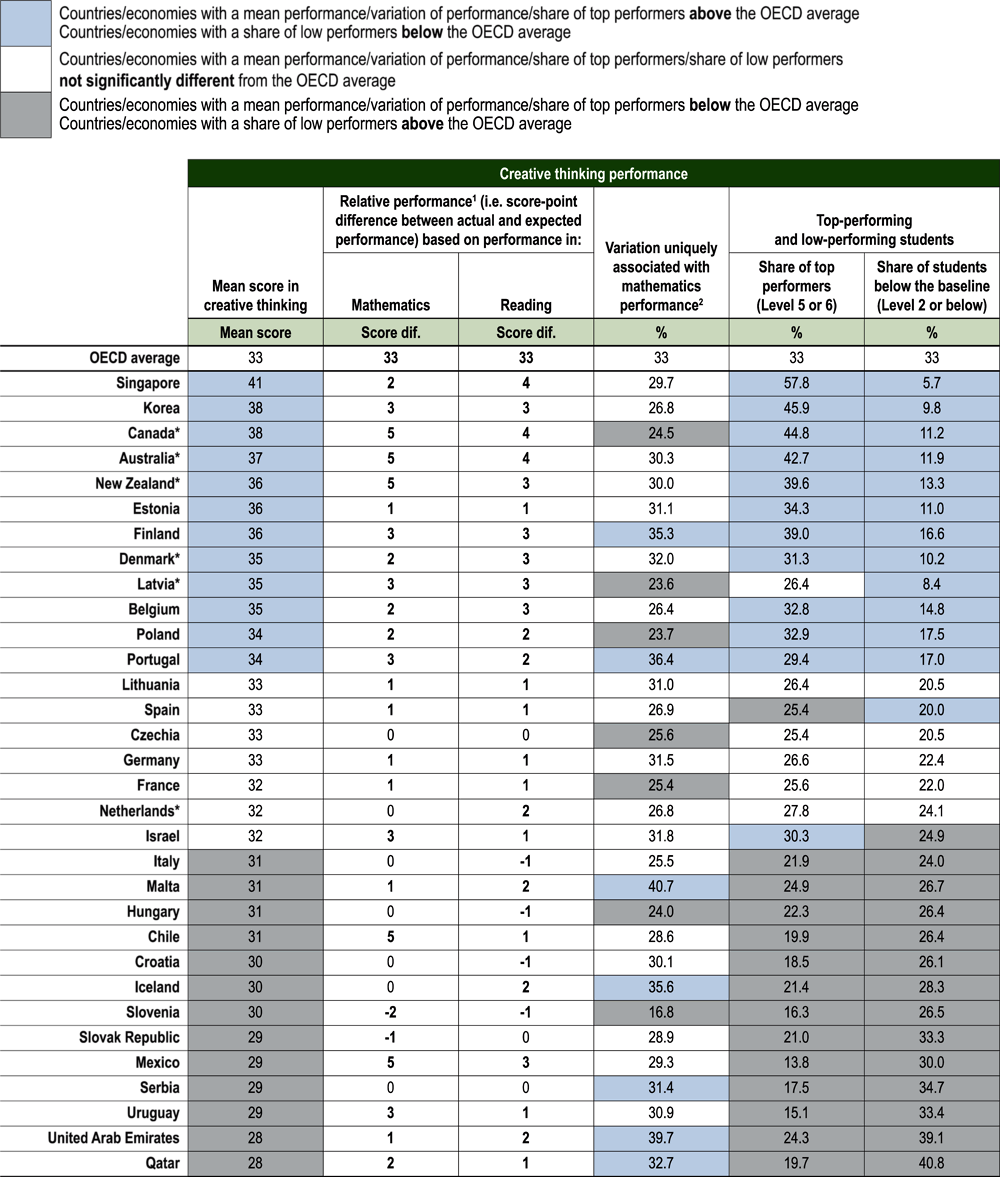
* Caution is required when interpreting estimates because one or more PISA sampling standards were not met. ** Caution is required when comparing estimates with other countries/economies as a strong linkage to the international PISA creative thinking scale could not be established (see Reader's Guide and Annex A4).
1: A student's relative performance in creative thinking is defined as the residual obtained upon a cubic polynomial regression of the student's performance in creative thinking over his or her performance in mathematics (reading). The regression is performed at an international level, pooling data from all countries and economies that participated in the creative thinking assessment. 2. Explained variance is the R squared coefficient from a regression of creative thinking score on mathematics performance, gender and students' and schools' socio-economic profile (ESCS). Variation uniquely associated with mathematics performance is measured as the difference between the R squared of the full regression and the R squared of the same regression without mathematics performance.
Note: Values that are statistically significant are marked in bold (see Annex A3). Countries and economies are ranked in descending order of the mean performance in creative thinking.
Source: OECD, PISA 2022 Database, Tables III.B1.2.1, III.B1.2.2 and III.B1.2.4. The StatLink URL of this table is available below Snapshot Table III.6
Table III.2. Snapshot of gender gaps in performance

* Caution is required when interpreting estimates because one or more PISA sampling standards were not met (see Reader’s Guide, Annexes A2 and A4).
** Caution is required when comparing estimates with other countries/economies as a strong linkage to the international PISA creative thinking scale could not be established (see Reader's Guide and Annex A4).
Note: Values that are statistically significant are marked in bold (see Annex A3).
Countries and economies are ranked in descending order of the gender gap (boys-girls) in creative thinking performance.
Source: OECD, PISA 2022 Database, Tables III.B1.3.2 and III.B1.3.3. The StatLink URL of this table is available below Snapshot Table III.6
Table III.3. Snapshot of socio-economic disparities in performance

* Caution is required when interpreting estimates because one or more PISA sampling standards were not met. ** Caution is required when comparing estimates with other countries/economies as a strong linkage to the international PISA creative thinking scale could not be established (see Reader's Guide and Annex A4).
1. ESCS refers to the PISA index of economic, social and cultural status.
2. A socio-economically advantaged (disadvantaged) student (school) is a student (school) in the top (bottom) quarter of ESCS in his or her own country/economy.
3. Academically resilient students are disadvantaged students who scored in the top quarter of performance in creative thinking amongst students in their own country/economy.
Note: Values that are statistically significant are marked in bold (see Annex A3).
Countries and economies are ranked in ascending order of the percentage of variance in creative thinking performance explained by ESCS.
Source: OECD, PISA 2022 Database, Tables III.B1.3.7 and III.B1.3.15. The StatLink URL of this table is available below Snapshot Table III.6
Table III.4. Snapshot of performance across ideation processes and context domains
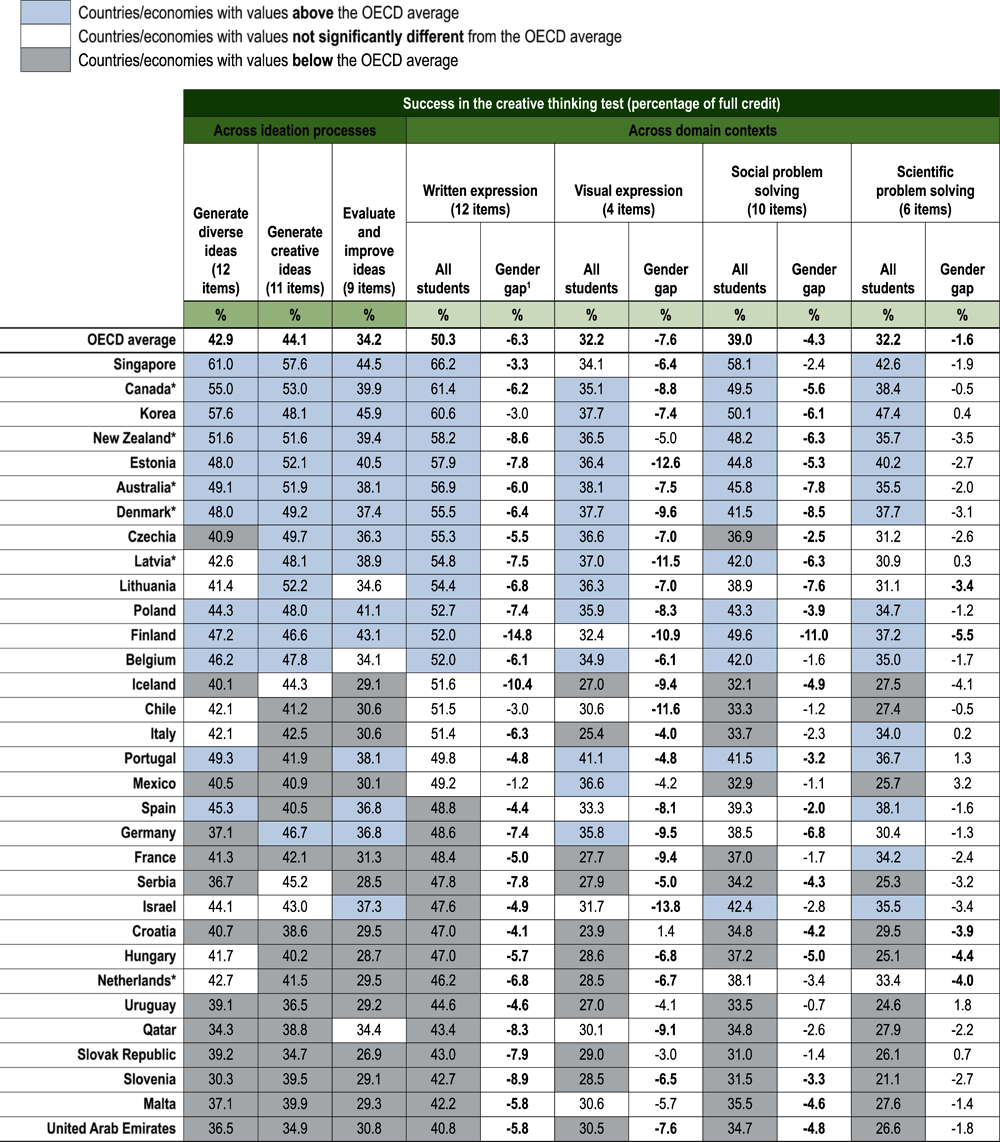
* Caution is required when interpreting estimates because one or more PISA sampling standards were not met (see Reader’s Guide, Annexes A2 and A4).
** Caution is required when comparing estimates with other countries/economies as a strong linkage to the international PISA creative thinking scale could not be established (see Reader's Guide and Annex A4).
1. The gender gap is the difference between boys' and girls' relative successes across the four domain contexts of the test. For each domain context, the relative success is the difference between the percentage of correct responses in this domain context and the average percent correct in all other tasks (full credit only).
Note: Values that are statistically significant are marked in bold (see Annex A3).
Countries and economies are ranked in descending order of the mean percentage in written expression.
Source: OECD, PISA 2022 Database, Tables III.B1.4.1, III.B1.4.2 and III.B1.4.8. The StatLink URL of this table is available below Snapshot Table III.6
Table III.5. Snapshot of beliefs, attitudes and social-emotional characteristics positively related to creative thinking
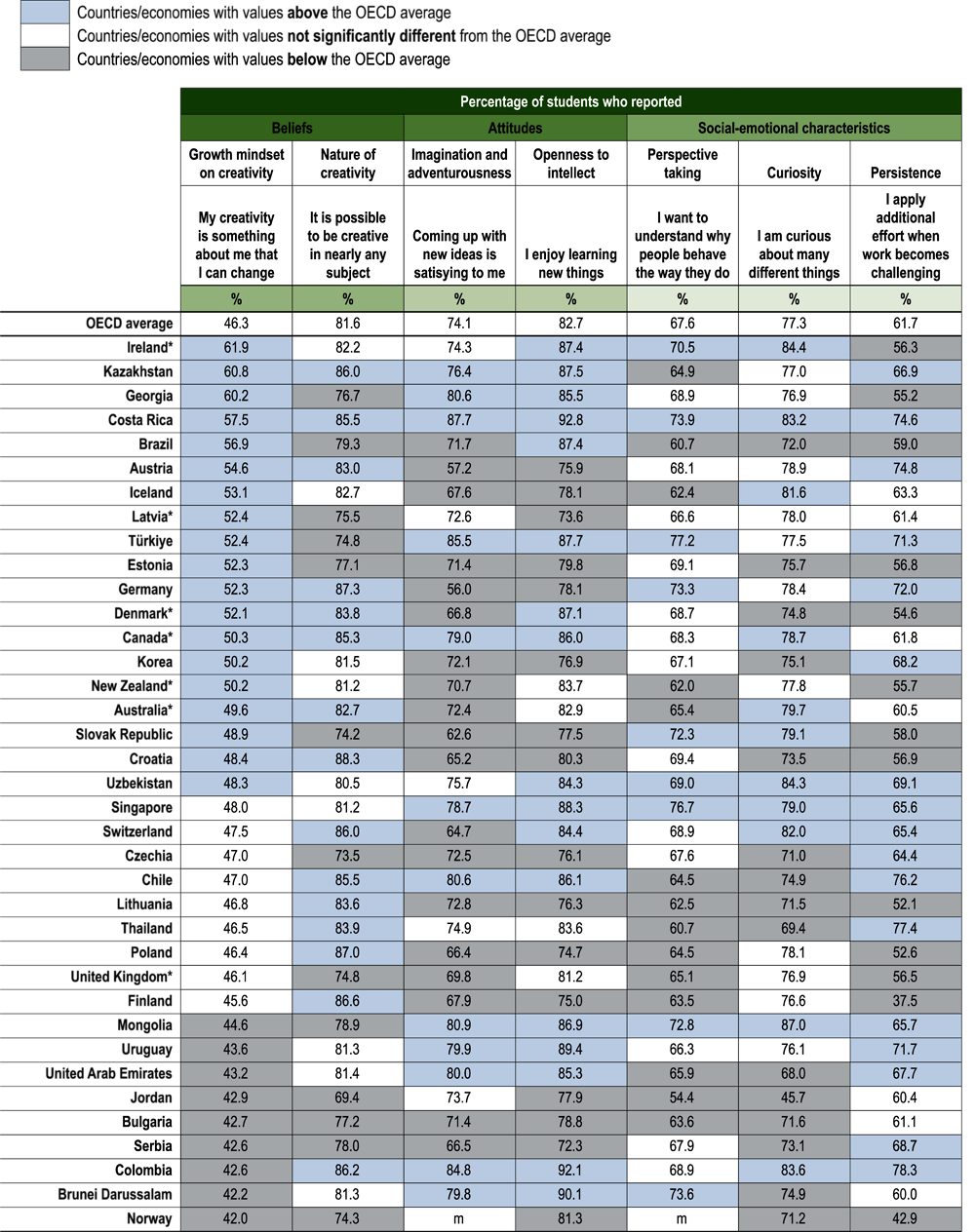
* Caution is required when interpreting estimates because one or more PISA sampling standards were not met (see Reader’s Guide, Annexes A2 and A4). Countries and economies are ranked in descending order of the percentage of students who reported "My creativity is something about me that I can change". Source: OECD, PISA 2022 Database, Tables III.B1.5.1, III.B1.5.4, III.B1.5.11, III.B1.5.19, III.B1.5.23, III.B1.5.29 and III.B1.5.33. The StatLink URL of this table is available below Snapshot Table III.6
Table III.6. Snapshot of school environment conductive to creative thinking
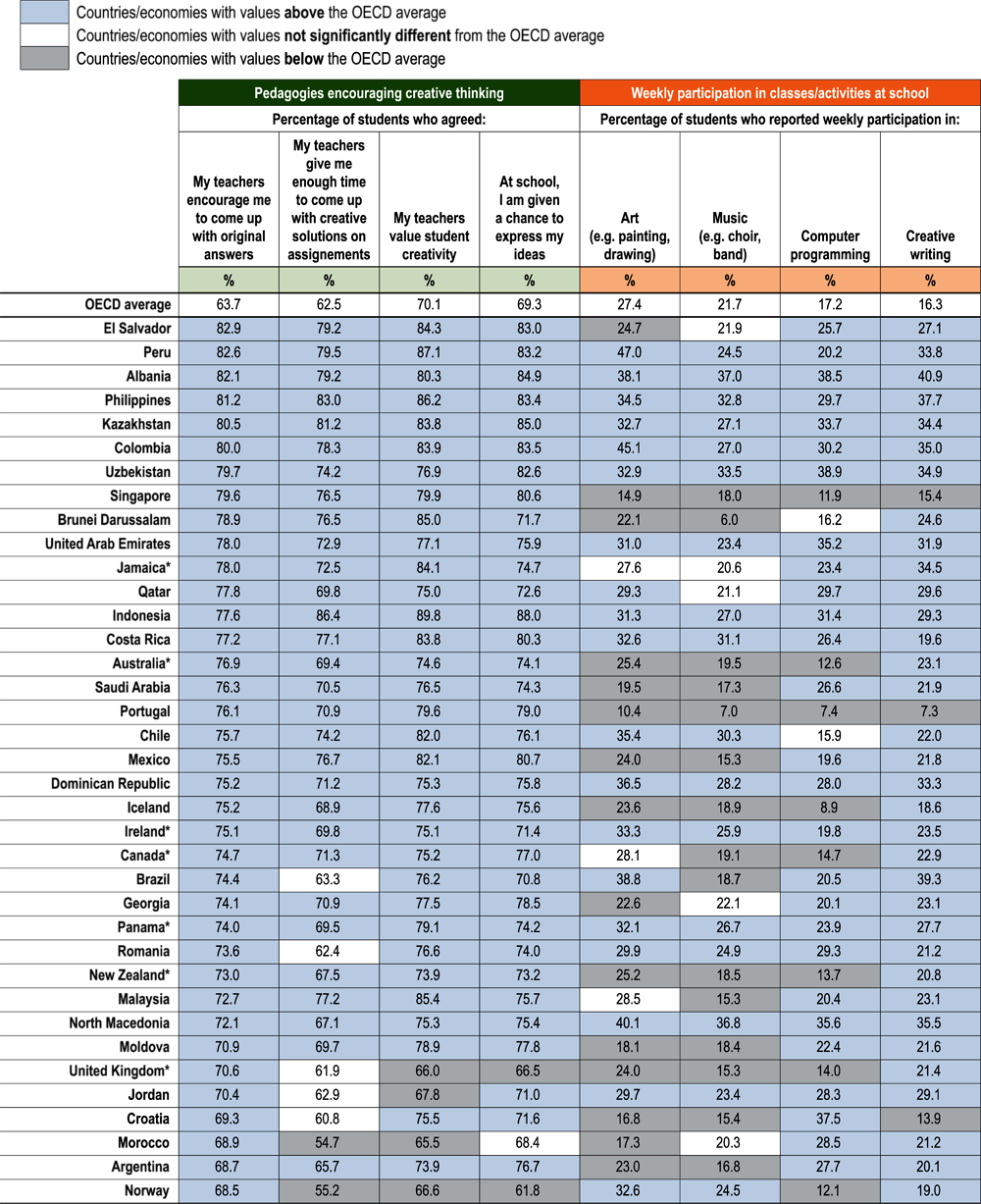
Table III.6. Snapshot of school environment conductive to creative thinking
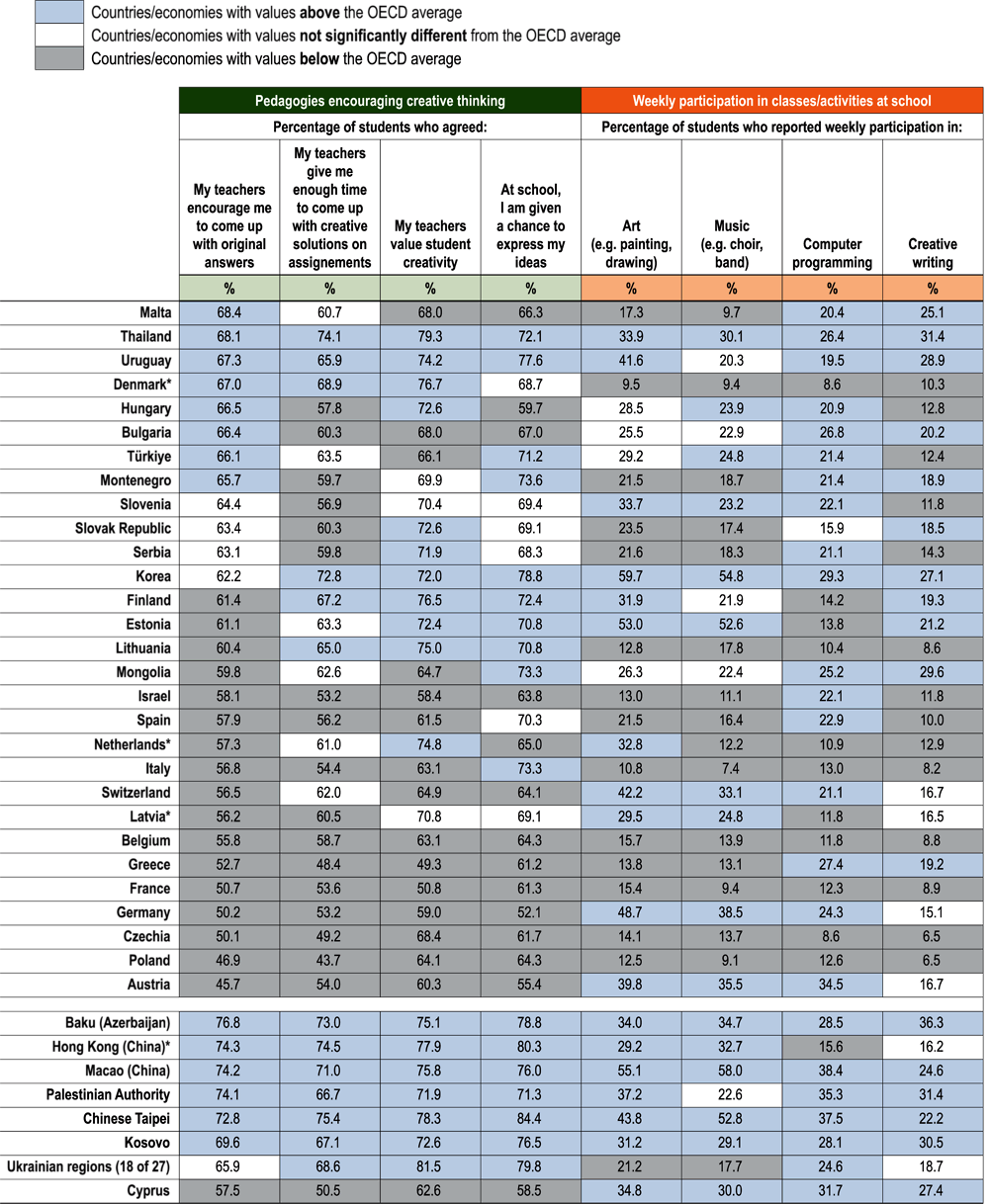
Note: * Caution is required when interpreting estimates because one or more PISA sampling standards were not met (see Reader’s Guide, Annexes A2 and A4).
Countries and economies are ranked in descending order of the percentage of students who reported their teachers encourage them to come up with original answers.
Source: OECD, PISA 2022 Database, Tables III.B1.6.1 and III.B1.6.6.